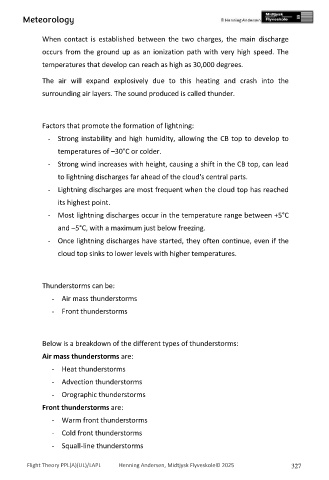Page 327 - PPL-engelsk 2025
P. 327
Meteorology
When contact is established between the two charges, the main discharge
occurs from the ground up as an ionization path with very high speed. The
temperatures that develop can reach as high as 30,000 degrees.
The air will expand explosively due to this heating and crash into the
surrounding air layers. The sound produced is called thunder.
Factors that promote the formation of lightning:
- Strong instability and high humidity, allowing the CB top to develop to
temperatures of –30°C or colder.
- Strong wind increases with height, causing a shift in the CB top, can lead
to lightning discharges far ahead of the cloud's central parts.
- Lightning discharges are most frequent when the cloud top has reached
its highest point.
- Most lightning discharges occur in the temperature range between +5°C
and –5°C, with a maximum just below freezing.
- Once lightning discharges have started, they often continue, even if the
cloud top sinks to lower levels with higher temperatures.
Thunderstorms can be:
- Air mass thunderstorms
- Front thunderstorms
Below is a breakdown of the different types of thunderstorms:
Air mass thunderstorms are:
- Heat thunderstorms
- Advection thunderstorms
- Orographic thunderstorms
Front thunderstorms are:
- Warm front thunderstorms
- Cold front thunderstorms
- Squall-line thunderstorms
Flight Theory PPL(A)(UL)/LAPL Henning Andersen, Midtjysk Flyveskole© 2025 327

